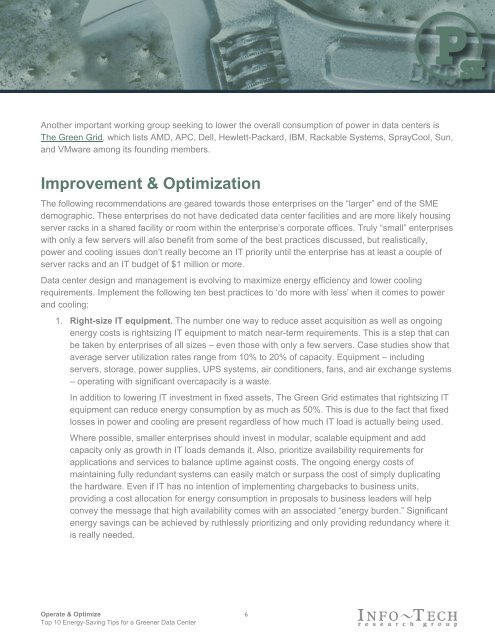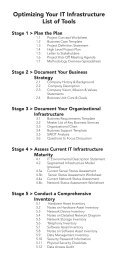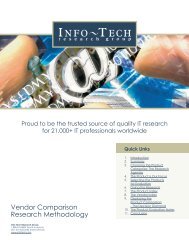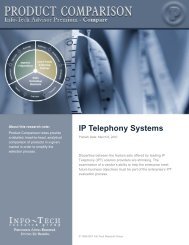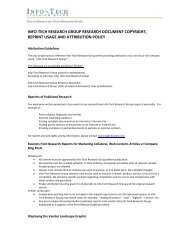Top 10 Energy-Saving Tips for a Greener Data Center - Info-Tech ...
Top 10 Energy-Saving Tips for a Greener Data Center - Info-Tech ...
Top 10 Energy-Saving Tips for a Greener Data Center - Info-Tech ...
Create successful ePaper yourself
Turn your PDF publications into a flip-book with our unique Google optimized e-Paper software.
Another important working group seeking to lower the overall consumption of power in data centers isThe Green Grid, which lists AMD, APC, Dell, Hewlett-Packard, IBM, Rackable Systems, SprayCool, Sun,and VMware among its founding members.Improvement & OptimizationThe following recommendations are geared towards those enterprises on the “larger” end of the SMEdemographic. These enterprises do not have dedicated data center facilities and are more likely housingserver racks in a shared facility or room within the enterprise’s corporate offices. Truly “small” enterpriseswith only a few servers will also benefit from some of the best practices discussed, but realistically,power and cooling issues don’t really become an IT priority until the enterprise has at least a couple ofserver racks and an IT budget of $1 million or more.<strong>Data</strong> center design and management is evolving to maximize energy efficiency and lower coolingrequirements. Implement the following ten best practices to ‘do more with less’ when it comes to powerand cooling:1. Right-size IT equipment. The number one way to reduce asset acquisition as well as ongoingenergy costs is rightsizing IT equipment to match near-term requirements. This is a step that canbe taken by enterprises of all sizes – even those with only a few servers. Case studies show thataverage server utilization rates range from <strong>10</strong>% to 20% of capacity. Equipment – includingservers, storage, power supplies, UPS systems, air conditioners, fans, and air exchange systems– operating with significant overcapacity is a waste.In addition to lowering IT investment in fixed assets, The Green Grid estimates that rightsizing ITequipment can reduce energy consumption by as much as 50%. This is due to the fact that fixedlosses in power and cooling are present regardless of how much IT load is actually being used.Where possible, smaller enterprises should invest in modular, scalable equipment and addcapacity only as growth in IT loads demands it. Also, prioritize availability requirements <strong>for</strong>applications and services to balance uptime against costs. The ongoing energy costs ofmaintaining fully redundant systems can easily match or surpass the cost of simply duplicatingthe hardware. Even if IT has no intention of implementing chargebacks to business units,providing a cost allocation <strong>for</strong> energy consumption in proposals to business leaders will helpconvey the message that high availability comes with an associated “energy burden.” Significantenergy savings can be achieved by ruthlessly prioritizing and only providing redundancy where itis really needed.Operate & Optimize 6<strong>Top</strong> <strong>10</strong> <strong>Energy</strong>-<strong>Saving</strong> <strong>Tips</strong> <strong>for</strong> a <strong>Greener</strong> <strong>Data</strong> <strong>Center</strong>


